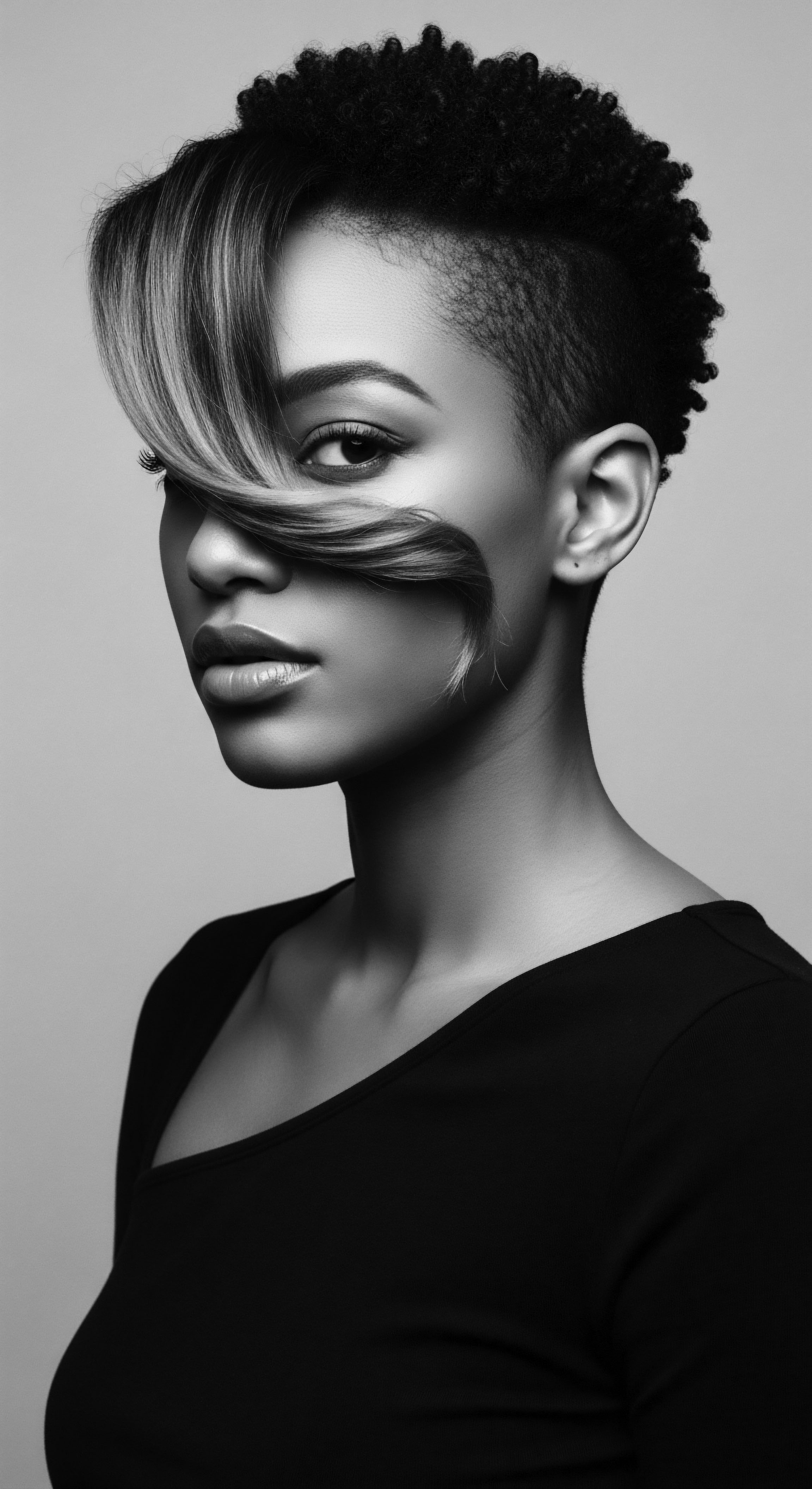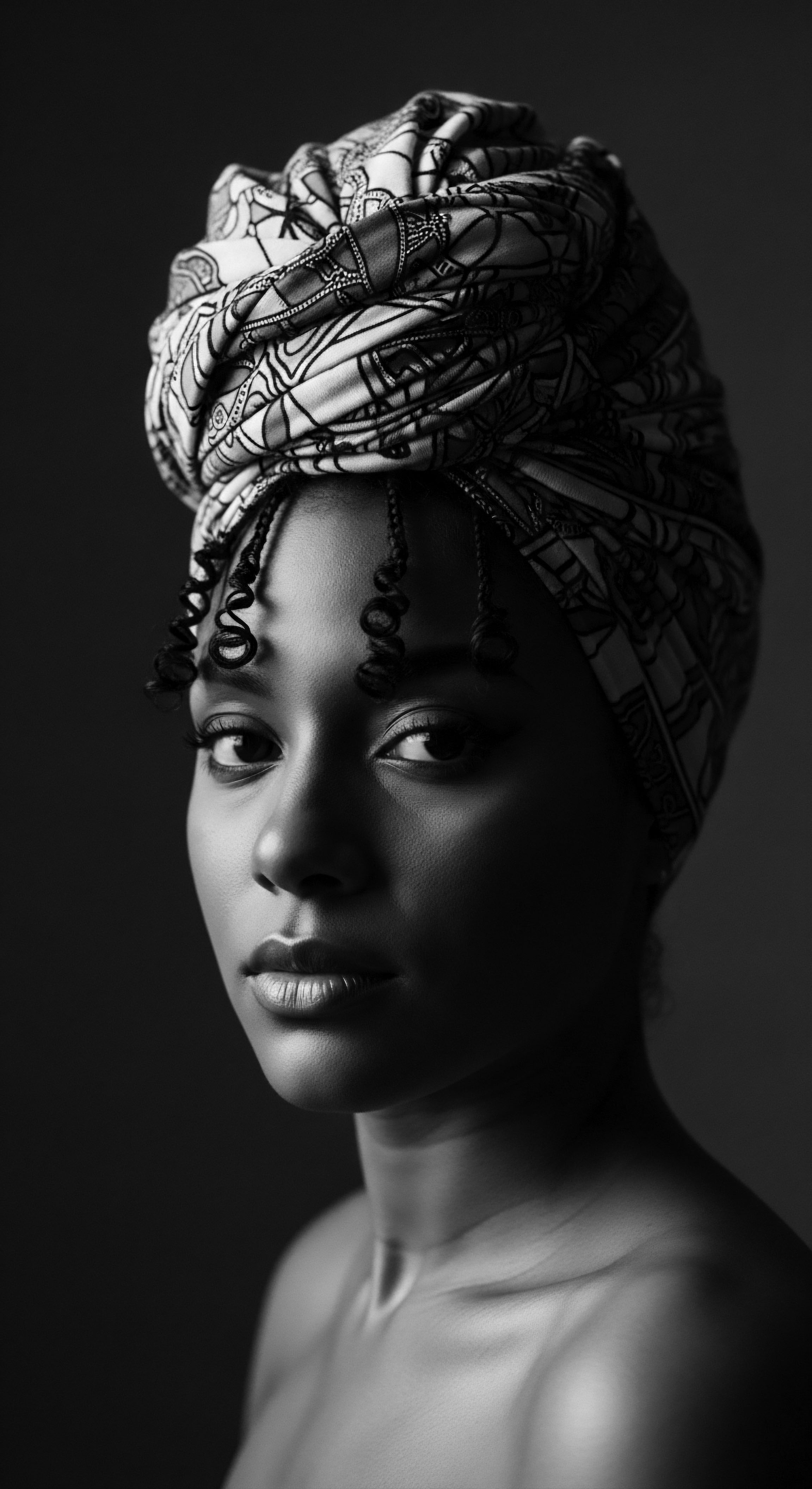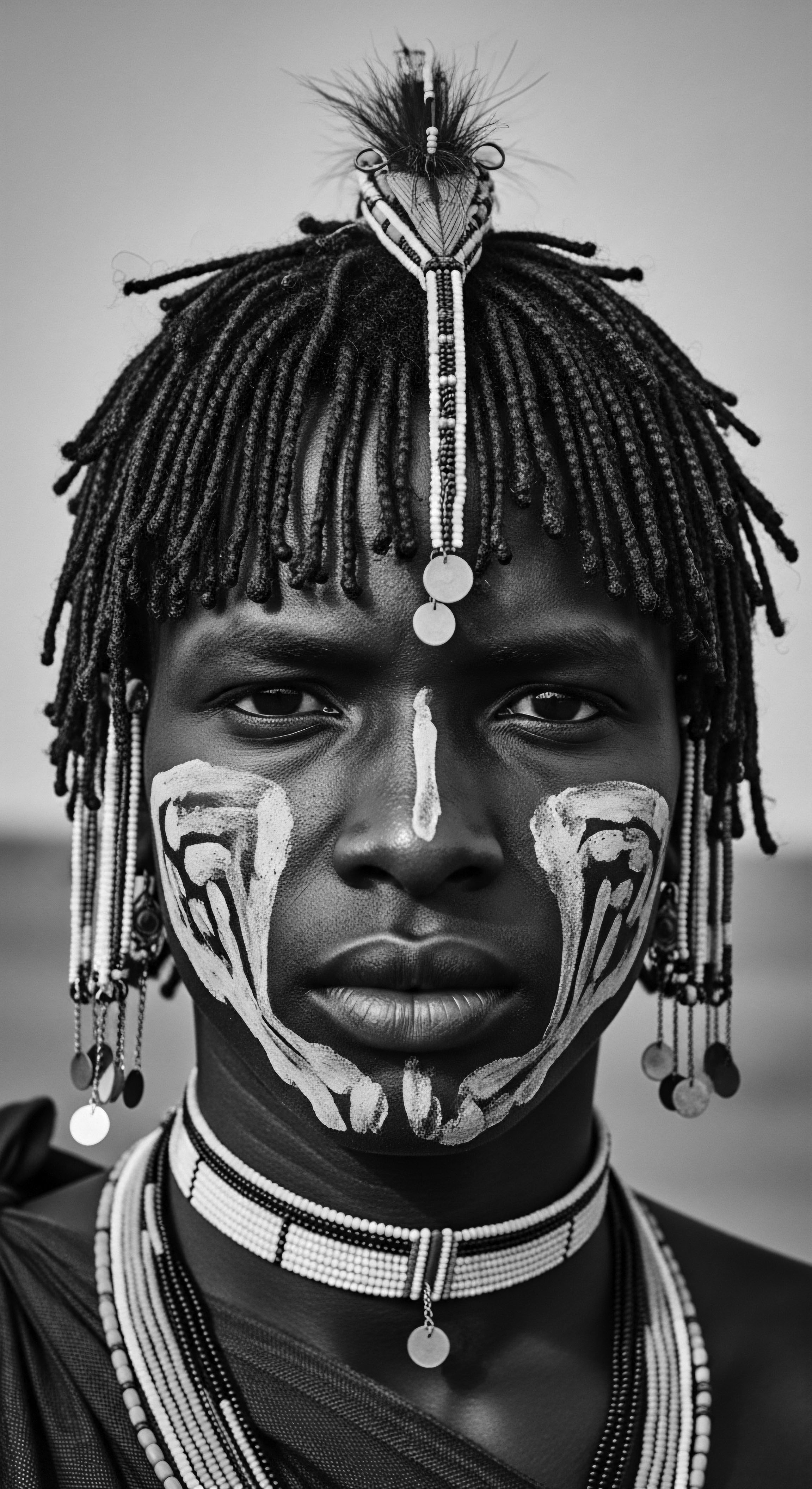
Roots
Consider for a moment the profound memory held within each strand of textured hair, a filament tracing back through generations, a living archive whispered across continents and epochs. It is a heritage not merely of biology but of persistent adaptation, ingenious care, and defiant beauty. For those whose crowns carry the complex geometries of coils, kinks, and waves, the night has long been a sacred threshold, a time not for neglect, but for intentional guardianship. This exploration begins at the very source of such traditions, seeking to understand how elemental wisdom shaped the protective rituals for textured hair as twilight descended.
The architectural marvel of textured hair, with its elliptical follicle, varied curl patterns, and tendency towards dryness due to the winding path sebum must travel, presents unique care requirements. Ancient communities, without microscopes or chemical analyses, observed these characteristics with an intuitive understanding born of daily lived experience. Their knowledge, passed down through oral traditions and hands-on guidance, recognized the vulnerability of these magnificent coils to friction, moisture loss, and tangling during periods of rest. The solutions they crafted were not coincidental; they were direct responses to the hair’s inherent structure, an early form of bio-mimicry applied to personal care.

Anatomy and Ancestral Understanding of Textured Hair
The very structure of a textured strand offers a fascinating study. Unlike straight hair, which tends to be round in cross-section, coily and curly hair often boasts an elliptical or even ribbon-like shape. This structural deviation means the cuticle, the outer protective layer, is raised at the bends of the curl, making it more susceptible to damage from rubbing and environmental stressors. This natural inclination towards vulnerability meant that nighttime, with its hours of unconscious movement against surfaces, posed a constant threat.
Ancestral wisdom, honed over millennia, recognized this fragility. Care practices were developed to minimize friction and prevent the loss of natural oils. This understanding wasn’t codified in scientific journals but in the communal acts of braiding, twisting, and wrapping hair before sleep.
These were not simply acts of vanity; they were acts of preservation, ensuring the vitality of the hair for the day ahead, for ceremonies, for identity. The choice of materials for head coverings and sleeping surfaces also speaks to this deep awareness of friction and moisture retention.
The protective rituals of nighttime hair care for textured hair trace back to an intuitive, generational understanding of hair’s unique structural needs.

Early Classifications and the Language of Hair
Before modern classification systems emerged, communities possessed their own vocabularies for hair types, often tied to kinship, spiritual beliefs, or social standing. While precise numerical types were absent, descriptive terms surely captured the range of textures within a group, influencing how protective measures were applied. For instance, hair that tangled easily or broke often might be described with terms that suggested ‘gentle handling’ or ‘needing binding,’ leading to specific nighttime preparations. The language used, though unwritten, shaped collective understanding of hair’s care.

Cultural Naming of Hair Textures
- Kinky Coils ❉ Often described with terms that conveyed denseness, strength, and a close relationship to the scalp, indicating a need for careful, segment-by-segment handling, especially for nighttime bundling.
- Loose Curls ❉ Characterized by terms suggesting softness, movement, and a tendency to unravel, highlighting the importance of gentle wrapping to maintain shape.
- Wavy Patterns ❉ Phrases that might denote flow and natural definition, suggesting that lighter coverings or specific braiding patterns would preserve their natural form overnight.
These early ways of describing hair texture were not merely labels; they were directives for care, a heritage of empirical observation guiding the nightly protection rituals.

Growth Cycles and Environmental Influences
The cycle of hair growth, with its anagen (growth), catagen (transition), and telogen (rest) phases, influences its overall health and how it responds to care. Historical communities understood, perhaps instinctively, that healthy hair growth was tied to broader wellbeing. Environmental factors, too, played a significant role. Climates with high humidity, for instance, might necessitate different protective measures at night to prevent excessive frizz or shrinkage compared to drier environments, where moisture retention became paramount.
Traditional materials for wraps and coverings reflected these localized needs, adapting to the specific challenges posed by climate. This geographical wisdom, deeply tied to the land and its offerings, became a cornerstone of their nighttime hair protection strategies.

Ritual
The hours of darkness, when the world quieted and bodies sought rest, transformed into a canvas for diligent care for textured hair. This was not a mere routine but a true ritual, imbued with intention and the quiet power of ancestral wisdom. The practices employed were deeply practical, yet held an almost ceremonial significance, preparing the hair not only for physical protection but for the symbolic renewal of a new day. These nightly preparations spoke volumes about a culture’s reverence for hair as a crown, a statement of identity, and a repository of personal and collective history.

The Nighttime Sanctuary Essential Sleep Protection
For generations, the simplest, yet most impactful, act of nighttime hair care involved containment. Hair left loose and unrestrained during sleep was prone to friction against rough sleeping surfaces, leading to tangles, breakage, and moisture loss. Thus, various methods of gathering and securing the hair emerged, each designed to minimize disturbance and preserve its structure.
The use of specialized head coverings, often crafted from smooth, natural fibers, represents a foundational aspect of this protective heritage. From intricately tied headwraps, such as those worn by women in various West African cultures, to simple cloths or nets, these coverings served as a crucial barrier. They prevented the hair from rubbing against abrasive pillows, absorbing moisture, and snagging on fasteners. This foresight was not just about maintaining appearance; it was about preserving the hair’s very strength, minimizing the need for constant manipulation and re-styling, which could further weaken already delicate strands.

How Did Traditional Head Coverings Protect Hair?
Traditional head coverings protected textured hair through several key mechanisms:
- Reduced Friction ❉ Smooth inner linings, often of silk or finely woven cotton, provided a glide surface, preventing the cuticle from roughening or lifting during sleep.
- Moisture Retention ❉ The enclosure created a microclimate, trapping natural oils and applied emollients, which would otherwise evaporate or be absorbed by typical pillowcases.
- Tangle Prevention ❉ By securing the hair in a contained state—whether braided, twisted, or simply gathered—the covering prevented individual strands from knotting together.
- Shape Preservation ❉ For styles like braids or coils, the covering helped maintain their integrity and definition, extending the life of the style and reducing daily manipulation.
These practical benefits were woven into the daily rhythm, becoming an inseparable part of beauty and wellbeing practices.

Ancestral Roots of Protective Styling
Beyond coverings, the styling of hair itself became a protective measure. Braiding, twisting, and knotting techniques, practiced across African diasporic communities, were not only aesthetic expressions but strategic preparations for sleep. Hair coiled into neat knots, like the traditional bantu knots, or meticulously braided, such as cornrows or individual plaits, dramatically reduced the surface area exposed to friction. These styles kept the hair contained, preventing it from splaying out and rubbing against bedding.
| Traditional Method Headwraps (e.g. geles, turbans) |
| Purpose of Nighttime Practice Shields hair from friction, preserves moisture, maintains styles. |
| Cultural Connection / Benefit A symbol of modesty, status, or identity in many cultures, repurposed for functional hair protection. |
| Traditional Method Bantu Knots |
| Purpose of Nighttime Practice Collects sections of hair, prevents tangling, allows for setting curls. |
| Cultural Connection / Benefit Rooted in Southern African hair traditions, a versatile style that serves both protective and aesthetic roles. |
| Traditional Method Braids/Plaits (single or cornrows) |
| Purpose of Nighttime Practice Secures hair in elongated, compact forms, reduces breakage. |
| Cultural Connection / Benefit Ancient African practice, often carrying social and spiritual significance, adapted for long-term hair preservation. |
| Traditional Method These ancestral practices reveal a profound understanding of hair care, blending cultural expression with practical preservation. |
The knowledge of how tightly to braid, how much oil to apply, and which patterns offered optimal nightly safeguarding was a treasured legacy. This wisdom was not theoretical; it was embodied by elders, passed from mother to daughter, aunt to niece, through touch and shared experience. It was a language of care spoken not in words alone, but in the gentle parting of strands and the rhythmic motion of hands.

Ingredient Deep Dives for Nightly Needs
The effectiveness of nighttime protection was often amplified by the application of traditional ingredients. Plant-based oils and butters, gathered from the local environment, were routinely massaged into the scalp and hair before covering. Shea butter, sourced from the shea tree in West Africa, served as a powerful emollient, sealing moisture into the hair shaft.
Coconut oil, prevalent in coastal communities, offered both conditioning and a light barrier. These natural resources were understood to nourish the hair overnight, supporting its strength and preventing dryness, a primary cause of breakage.
The heritage of using natural ingredients for nightly applications was not just about their availability; it was about their intrinsic properties. These substances, often containing essential fatty acids and vitamins, supported the hair’s lipid barrier, making it more resilient to the stresses of daily life, including sleep. This understanding was empirical, born from generations of observation and collective testing, long before modern chemistry could quantify their benefits.

Relay
The wisdom of nighttime protection for textured hair, so deeply rooted in ancestral practices, has not remained static. It has been relayed across generations, adapting to new realities while preserving its essential core. This dynamic transmission highlights the enduring intelligence embedded within Black and mixed-race communities, a testament to resilience and ingenuity in the face of changing environments and social landscapes. The journey from ancient wrapping techniques to modern bonnet designs offers a compelling examination of continuity and adaptation, all framed by the unwavering priority of heritage.

How Does Modern Science Echo Ancestral Practices?
Contemporary hair science, with its advanced understanding of trichology and material properties, often provides validation for practices long observed by ancestral caregivers. For instance, the traditional use of smooth head coverings, like those made from silk, finds its scientific corroboration in studies demonstrating the reduced friction and moisture absorption properties of silk compared to cotton. Research by specialists in textile science and cosmetology has shown that silk and satin fibers have a smoother surface at a microscopic level, causing less mechanical stress on the hair cuticle and thereby minimizing frizz and breakage during sleep (Robbins, 2012). This academic understanding simply articulates what generations of practice had already affirmed through observation ❉ that the soft, low-friction surface provides optimal protection.
Modern trichology often validates ancient nighttime hair care practices, confirming their effectiveness through scientific lens.
Consider the historical example of the Krio women of Sierra Leone. In the 18th and 19th centuries, after emancipation, these women became known for their sophisticated hairstyles and meticulous care routines. Their elaborate coiffures, often requiring hours of work, were not left to chance overnight. They would typically secure their hair in wraps, frequently utilizing smooth cloths, to preserve the style and integrity of their strands (Blay, 2007).
This practice, born of both necessity and cultural pride, protected their intricate creations and the health of their hair, demonstrating a long-standing tradition of intentional nighttime safeguarding long before commercial bonnets. This particular instance serves as a strong beacon, illuminating the continuity of protective wisdom across the diaspora.

Evolution of Nighttime Hair Accessories
The evolution of nighttime hair accessories illustrates this relay of wisdom beautifully. From the simple cloth wraps of antiquity to the satin-lined bonnets and pillowcases prevalent today, the underlying principle remains constant ❉ create a protective barrier. The materials may have shifted, influenced by global trade and industrialization, but the objective of friction reduction and moisture retention has persevered.
- Pre-Colonial African Wraps ❉ Often natural fibers, sometimes treated with plant oils, intricately tied to secure styles and prevent damage.
- Diasporic Headcoverings ❉ Post-emancipation, headwraps continued to serve as both cultural statement and practical hair protection, evolving with available fabrics.
- Modern Bonnets and Pillowcases ❉ The advent of manufactured silk and satin allowed for standardized, accessible tools that offered similar benefits to traditional methods.
This continuity speaks to the timeless nature of the problem and the enduring ingenuity of the solutions.

Understanding Hair Health and Holistic Influences
Traditional wisdom also extended beyond mere physical protection to a more holistic understanding of hair health. Hair was seen as an extension of the body’s overall vitality, influenced by diet, hydration, and emotional wellbeing. Nighttime care, then, was not just about the hair itself, but about a broader sense of rest and restoration that contributed to the body’s regenerative processes. This integrated approach, where hair care is intertwined with total wellness, finds resonance in modern wellness philosophies that emphasize diet, stress management, and adequate sleep for hair health.
The ancestral approach often recognized that external care was only one piece of the puzzle. Internal nourishment, achieved through traditional diets rich in vital nutrients, was seen as equally important. Many traditional African diets, for instance, were abundant in protein-rich legumes, leafy greens, and healthy fats, all of which supply the building blocks for strong hair growth. This internal commitment to hair vitality meant that nighttime protection was complemented by daily sustenance, reinforcing the idea that beauty radiates from within.

Reflection
The quiet hours of night, for generations past, were a sacred canvas upon which the care of textured hair was meticulously painted. It was a time of guardianship, a deliberate act of nurturing a strand that carried not only personal identity but the collective memory of a people. The wisdom that shaped these nighttime rituals for textured hair is a living, breathing archive, speaking volumes about ingenuity, cultural preservation, and a profound reverence for one’s inherent crown. This understanding, that a simple wrap or braid before sleep could be a powerful act of defiance against degradation, is a testament to the enduring soul within each strand.
The legacy of these practices continues to teach us. It reminds us that protection, whether through a meticulously tied headwrap of generations past or a contemporary satin bonnet, is not a superficial act. It is a dialogue with our heritage, a quiet acknowledgment of the challenges and triumphs that shaped our forebears, and a purposeful step towards nurturing the vitality of our own hair. These traditions, born of necessity and passed through knowing hands, offer more than just physical preservation; they offer a connection, a quiet reassurance that the wisdom of our ancestors, concerning even the most intimate aspects of self, remains a guiding light.

References
- Blay, E. (2007). Hair Story ❉ Untangling the Roots of Black Hair in America. St. Martin’s Press.
- Robbins, C. R. (2012). Chemical and Physical Behavior of Human Hair (5th ed.). Springer.
- Byrd, A. D. & Tharps, L. D. (2014). Hair Story ❉ Untangling the Roots of Black Hair in America (2nd ed.). St. Martin’s Griffin.
- Mercer, K. (1994). Welcome to the Jungle ❉ New Positions in Cultural and Identity Politics. Routledge.
- Akbar, N. (1998). Light from Ancient Africa. New Mind Productions.
